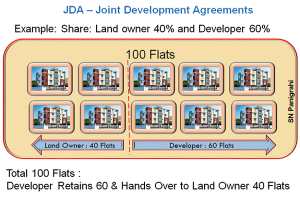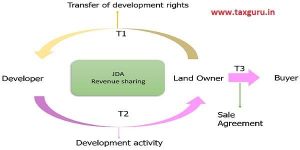This article is written by Tripti Gupta, pursuing a Certificate Course in Real Estate Laws from LawSikho.com.
Table of Contents
What is a Joint Development Agreement?
- To understand what is a Joint Development Agreement (JDA), let’s start with the story of Mr. X who has inherited and now owns 5 acres of land in the Brijwasan area of New Delhi. He is looking for avenues to earn revenue from it. He may lease it out, or use it as a commercial property. Another alternative is to wait for the price of the land to appreciate and hold it for a good amount of time. Yet another alternative is to get a building constructed, residential or commercial, and sell or rent out the units. But for that, Mr. X will not only have to arrange for additional finance required for the construction but will also have to get approvals and look after the construction activities. He might not have the requisite expertise, time, and money to complete the construction.
- On the other hand, there is Mr. Y who is a developer of good repute, has the requisite funds, skills, and knowledge to undertake construction activity. He might have to block his funds to purchase the piece of land in the first place because purchasing the land contributes a large part of the total investment. As a result, he might fall short of the funds required for the construction activity.
- Now Mr. X, the landowner, and Mr. Y, the developer can enter into an arrangement in which Mr. X contributes the land and Mr. Y undertakes the development and construction of new buildings/projects at his costs. Such an arrangement is termed a Joint Development Agreement (JDA) and is beneficial to both the owner of the land and the developer.
- The Joint Development Agreement (JDA) resembles the barter system that was prevalent in ancient times, long before the concept of money was around. There are two models of Joint Development Agreement (JDA).
A. Area Sharing Joint Development Agreement (JDA)
Example: Developer Mr. Y enters into a JDA with the landowner Mr. X wherein as per the agreement a total of 100 residential units will be constructed by Mr. Y on the land provided by Mr. X. In this agreement, 40% of the units i.e. 40 units shall be given to Mr. X and the rest 60 units shall be taken by Mr. Y. Both the parties can commercially sell the units in the open market. The landowner gets 40 units of flats in place of the land given and the developer gets 60 units of flats in place of the construction work done.

B. Revenue Sharing Joint Development Agreement (JDA)
Example: Developer, Mr. Y, enters into an agreement with the landowner Mr. X wherein a total of 100 residential units will be constructed by Mr. Y on the land provided by Mr. X. In the Revenue Sharing JDA model, the revenue accruing from the sale of plotted land is divided between Mr. X, the landowner, and Mr. Y, the developer in an agreed ratio, say for instance 75:25.

What are the advantages of a Joint Development Agreement?
Some of the significant advantages of entering into a Joint Development Agreement are:-
- The developer does not have to incur any initial investment for the procurement of the land.
- Partial avoidance of the payment of stamp duty.
- JDA results in the speedy development of the property as the working capital requirement is restricted towards approval and construction.
- The landlord reaps a competent consideration/lucrative offer in this arrangement.
- A secured loan can be obtained by pledging land, which is obtained under Joint Development Agreement.
What are the limitations of a Joint Development Agreement?
The Joint Development Agreements (JDA) is not devoid of any limitations. Some of them being:-
- The waiting time of the landowner to reap the profits may be a long period till the construction is completed. During this period, real estate might face ups and downs.
- The developer and the landowner are affected by the amendments in the statutes of the Income Tax Act.
- Prospective buyers while purchasing the units which are constructed under the Joint Development Agreement require due diligence by the prospective buyers before they enter into the builder-buyer agreement.
What are the rights and responsibilities of a developer in a Joint Development Agreement?
It is of immense importance that the landowner and the developer, before the construction of the property, decide in advance, the rights/responsibilities of each entity. Here are a few rights/responsibilities of the developer/builder in a Joint Development Agreement (JDA).
I. Licensee rights
The landowner grants a ‘licence’ to the developer to enter into his land with the full right as well as the authority to start, carry on and complete the development following the permission granted. This ‘licence’ granted by the landowner to the developer is the nature of a personal licence and under no circumstances will the developer assign his title, right as well as interest to any other party. It is important to use the word ‘licensee’ in a JDA. Then all the rights that a licensee has, will belong to the developer. This becomes important when there arises a dispute between the landowner and the developer. e.g. The developer can seek an injunction to enter the land, in case the landowner refuses the developer to enter his premises on account of the conflict. The developer’s capital has already been invested in the project. If the developer does not have the licensee’s rights, then he is left with no such remedy and his capital investment will be a useless and unprofitable wasted effort. Therefore, it is important that the developer is granted a ‘licence’ and this right is exquisitely drafted well in JDA clauses.
II. Development rights
Legally, the word ‘land’ not just includes the full title in the land but also rights which gives benefits associated with it. In the case of a Joint Development Agreement, the landowner transfers his development rights to the developer for the development of a project on his land. In other words, the right to develop the land is called ‘development rights’, in which the owner of the land authorizes a person (developer/builder) to develop a structure on land. These ‘development rights’ can be easily transferred, sold, or exchanged. Now let us understand the concept of development rights with an example:-
- Let Mr. X be the landowner and Mr. Y the developer. Mr. Y approaches Mr. X with a Joint Development proposal and Mr. X agrees to the proposal of developing the project on his land under the Joint Development Agreement. After completion of the project, Mr. Y sold some of the units to buyers with Mr. X’s consent. Mr. X will transfer the undivided share in land in favor of the outsider’s cooperative housing society. In this case, Mr. X’s permission will be granted in the form of transfer of development rights.
III. Right to seek approvals
The developer has the right to have separate contracts in his name with the contractor, architect, and others to carry out the development at his risks and costs. The landowner on entering into a Joint Development Agreement with the developer engages the developer to take full responsibility for the development work. The developer undertakes the responsibility of obtaining requisite approvals regarding development from the competent authorities, property development as well as launching, advertising, and marketing the project with the help of financial resources.
IV. General Power of Attorney (GPA)
As per the provisions of Section 53A (which deals with part-performance of a contract) of the Transfer of Property Act 1882, the developer shall not be a transferee or buyer of the development work under the JDA. The partnership between the two entities is restricted only till the project’s development and the JDA does not entitle the developer to sell the units on his own. The ownership of the land still lies with the landowner only. To facilitate the process of selling, the landowner will have to assign the right to the developer to sell the property. So, he confers the authority to the developer/builder by signing a General Power of Attorney (GPA). This gives the developer the right to sell and register agreed portions of land with respective undivided shares by way of flats to other buyers. Even then, it would be the landowner himself who will grant the conveyance deed in favor of the buyer after the completion of the unit and granting of the occupancy rights by the competent authority.
V. Right to take legal action
Co-operation from both the entities, the landowner and the developer is crucial in a Joint Development Agreement (JDA). JDA should provide for the possible repercussions in case there is a failure by one or more parties to fulfill the agreed responsibilities. Therefore, if the landowner fails to cooperate with the developer, the developer has sufficient rights to sue against the landowner in a court of law. There may be instances that the landowner fails to get a clear title and this flaw comes to light, post-completion of construction. Not only this, but it is also possible that the whole construction by the developer gets challenged in the court of law on account of the absence of a clear title. The developer, in such cases of any breach of the terms of the agreement by the landowner, can take legal action against him. Also, in case of any breach of the terms of the agreement by the developer, the landowner has the right to revoke the Power of Attorney as well as take legal action against the developer.
Conclusion
Both the documents, the JDA and the GPA, must be registered with an appropriate value of stamp paper with the Registrar, for the contract to become legal. Even after registration of both the JDA and the GPA, it is required by both parties to cooperate at every instance to avail of the benefits of a JDA. Hence, paperwork and communication play a vital role. The clauses of a Joint Development Agreement should be drafted in such a manner that they categorically elucidate the rights and responsibilities of the developer/builder and the landowner. When the developer and the landowner enter into a Joint Development Agreement, both the parties invest their time, money, and resources for the long haul, so consistent and clear communication between the two parties is the success mantra in such associations. In case any issues arise between the two parties, it might not take long for the relations between them to turn sour, and consequently, the entire deal to get stuck.
References
- Videos on Joint Development Agreement by Ajar Rab (Partner Rab & Rab Associates)
- https://housing.com/news/joint-development-agreement/
- https://blog.ipleaders.in/primer-different-aspects-joint-development-agreements/
- https://www.nitinbhatia.in/real-estate/joint-development-agreement/
- https://blog.ipleaders.in/builders-landowners-enter-jda-gpa-agreement-joint-development/
- https://www.thehindu.com/real-estate/your-legal-queries-answered/article32750998.ece
- https://www.99acres.com/articles/all-that-you-need-to-know-about-a-joint-development-agreement.html
Students of LawSikho courses regularly produce writing assignments and work on practical exercises as a part of their coursework and develop themselves in real-life practical skills.
LawSikho has created a telegram group for exchanging legal knowledge, referrals, and various opportunities. You can click on this link and join:












